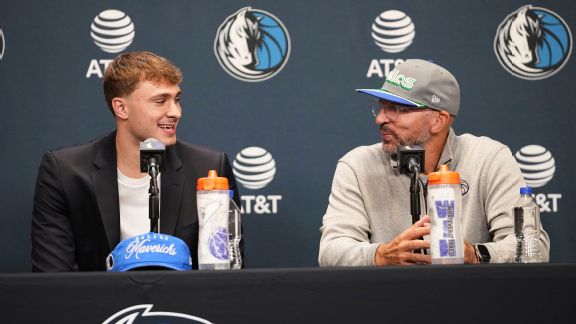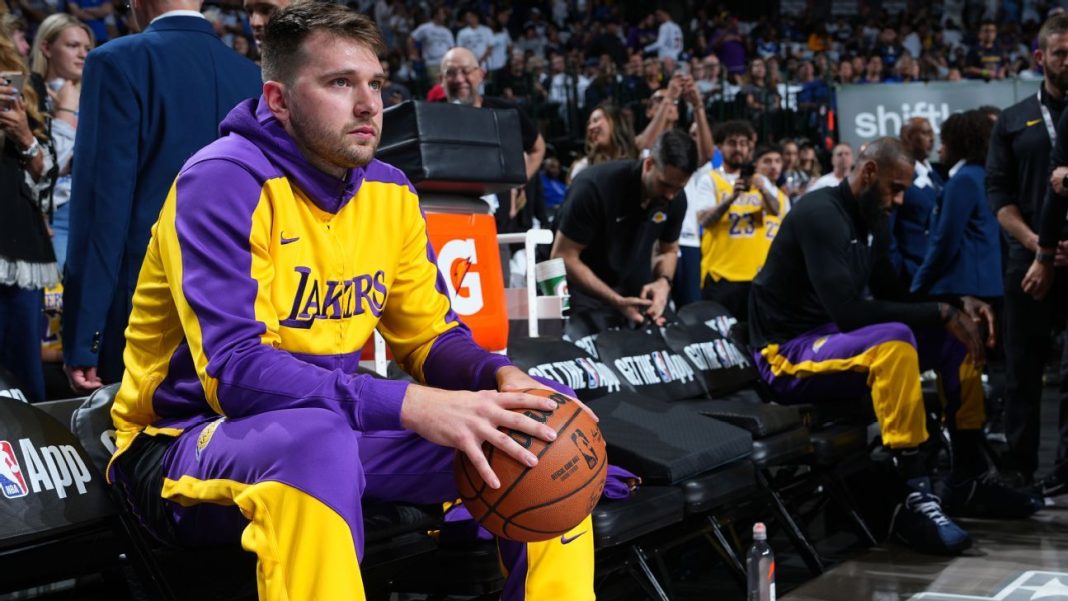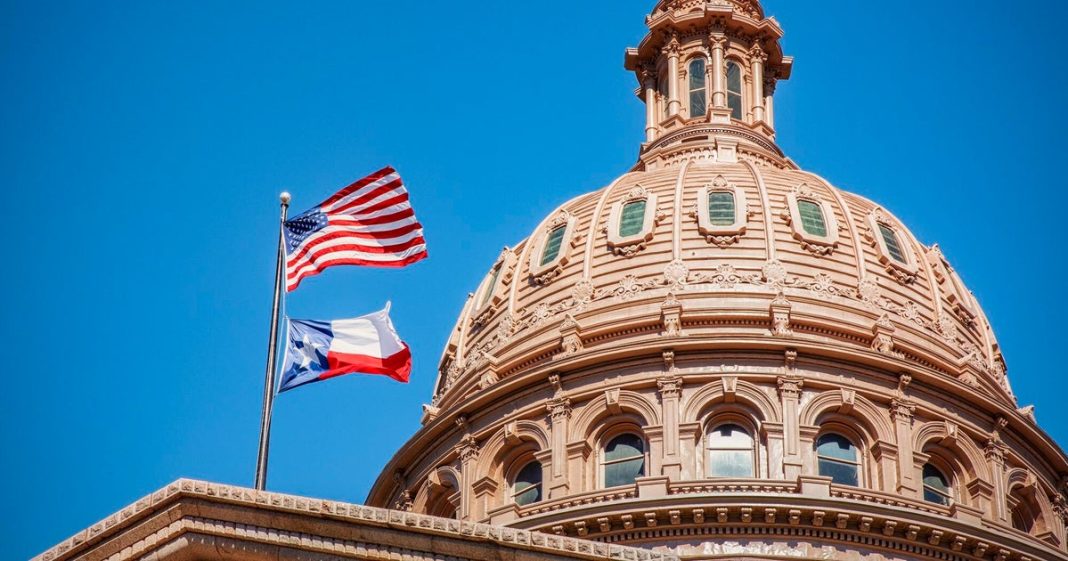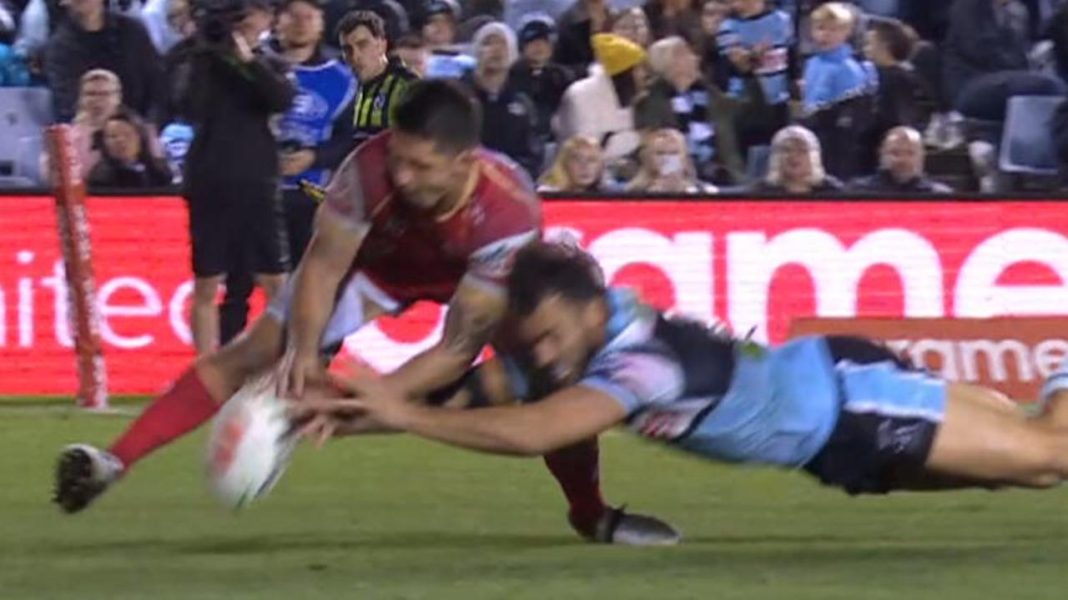


THERE ARE TWO entrances to Craig’s restaurant on Melrose Avenue in the West Hollywood section of Los Angeles. Those who don’t mind being seen by the gaggle of paparazzi that mill about outside the notorious celebrity hangout enter through the front door. Those who don’t want to be seen enter through the private entrance at the back.
Once a celebrity is safely inside, the tinted windows and dim lighting offer the kind of privacy where real business can be discussed over very expensive, very good bottles of wine and elevated comfort food like pigs in a blanket or honey truffle chicken.
On May 3, four days after the Los Angeles Lakers were eliminated in the first round of the playoffs by the Minnesota Timberwolves, Craig’s reserved a booth for four VIPs: the Lakers’ new superstar point guard, Luka Doncic; his longtime manager, Lara Beth Seager; Lakers general manager Rob Pelinka; and coach JJ Redick.
LeBron James, the centerpiece of every Lakers decision and strategy for the previous seven-plus years, was not in attendance.
Redick, Pelinka and Seager entered through the front entrance, Doncic through the back.
But all four exited through the front door, where a crowd of paparazzi and fans spotted them and took videos that were immediately uploaded to TMZ and social media. Doncic even stopped to sign a few autographs before leaving.
The purpose of the meeting was as clear as their choice of door: Doncic is the face of the franchise now and the Lakers wanted him — and everyone else — to know it.
Over a bottle of Opus One, Pelinka and Redick explained not only their strategy in building the team around Doncic’s skill set, sources told ESPN, but also the complexities of the NBA’s new collective bargaining agreement and how they planned to navigate it.
That exquisite bottle of wine might have helped Doncic digest Pelinka’s explanation of arcane topics such as the second apron, the value of preserving salary cap space to help acquire an age-appropriate star alongside of him and what remained of the Lakers’ draft assets. Pelinka had made it a working dinner, toting in a thick binder with him.
That binder, with those offseason Laker plans and longer-range strategies and dreams, used to be presented to James at meetings such as these. When the concepts of chasing players the team eventually landed — like Anthony Davis and Russell Westbrook — and those they ultimately didn’t.
Pelinka has talked often to Doncic and Seager in the 3½ months since he had acquired the young star from the Dallas Mavericks in one of the most shocking trades in NBA history.
Pelinka met Doncic when he was getting off a private jet late on a Sunday in February, hours after the stunning trade, and later that week consulted him before making a later rescinded trade for Mark Williams, one of the centers Doncic had asked to play alongside.
But there wasn’t much time for relationship building in the middle of the season, and the Lakers are keenly aware — as is the rest of the league — that Doncic has a monumental decision to make starting Aug. 2, when he’s eligible to sign an extension with the team.
No matter what the Lakers did at their center position — they signed Deandre Ayton to be their starter — or how they added depth to the wing — landing Jake LaRavia — far and away the most important piece of offseason business for the Lakers is getting a commitment from Doncic.
The prized star can opt to be a free agent next summer under his current deal, and that’s an uncomfortable position for any franchise to be in. It’s one the Lakers would like to avoid by getting Doncic to accept a new deal.
Doncic can add four more years and $223 million, and the Lakers will assuredly offer exactly that, but he might prefer a three-year $160 million deal instead because it sets up better for future contracts. The Lakers will gladly accept either, though they may have to be patient; Doncic is playing for the Slovenian national team this summer in the high-intensity EuroBasket, which runs through mid-September, and his NBA contract business might wait until then.
But that is not the kind of topic you talk about over dinner at Craig’s in May, however. No, at that dinner plans are made to visit Doncic in Europe later this summer. Players he would like to team up with are discussed; the team’s style of play and organizational culture are examined.
Behind the tinted windows, the leaders of the Lakers’ organization sent a message to the star they hope will lead them: That this is what life in L.A. can be like if he elects to stay and be the next face of the franchise.
That message has been received warmly. “The Lakers leadership team has been incredibly welcoming and supportive of Luka since we arrived in L.A.,” Seager told ESPN. “We’ve spent a lot of time talking and getting to know each other over the last few months, and we’ve formed a strong working relationship. Championships are won when you work together. We all share that same goal.”
As the party exited out the front door, the franchise unofficially made that message public: It is ready to usher in the Luka Doncic era in Los Angeles, even if that means sunsetting the LeBron James one.
LESS THAN TWO months after that dinner meeting with Doncic, another important but quite different statement was made by the man who was not invited that night: the emeritus face of the franchise.
It came via Rich Paul, James’ longtime agent and confidant.
“We understand the difficulty in winning now while preparing for the future. We do want to evaluate what’s best for LeBron at this stage in his life and career,” Paul said in a statement to ESPN’s Shams Charania ahead of James’ decision to pick up the final year and $52.6 million player option on his contract on June 30.
“He wants to make every season he has left count, and the Lakers understand that, are supportive and want what’s best for him.”
The statement immediately sent the NBA world into a tizzy. Though it came with the news of James picking up his $52.6 million player option, contractually tying him to the Lakers for 2025-26, it read like a goodbye letter. It suggested a larger plan or strategy was afoot.
The gigantic trade that had landed Doncic in Los Angeles had formed sudden new realities, one of which was James eventually becoming an expiring contract for the first time in his 23-year career. It was the strongest sign yet that the end of his Lakers tenure was near.
Executives around the league scurried to decode it.
One Eastern Conference executive was convinced James wanted out of LA.
A handful of teams — including the Golden State Warriors, who tried to trade for James in 2023-24 — considered again whether to make an offer, sources said.
One Western Conference executive chalked it up to an elaborate pout because the Lakers hadn’t offered James a new contract extension.
Another Western Conference executive felt it was an attempt to pressure the Lakers’ front office to go all-in on building the team this season and away from its strategy to keep the cap sheet as clean as possible for the summers of 2026 and 2027 after James’ salary comes off the books.
Whatever the reason, its impact was immediate. Free agent center Brook Lopez, who league sources said had strongly considered the Lakers and the potential starting role, grew wary of the uncertainty around James’ future with the team and opted to sign with the rival LA Clippers, where he will be a backup.
Before he released the statement, Paul gave a heads-up to Doncic and the Lakers.
Paul called Seager, with whom he has a relationship, and wanted to extend an olive branch, sources said. He wanted to make it clear James has always appreciated Doncic’s admiration for him and knows that Doncic understands the business of the league. That this wasn’t a reflection on how James felt about their experience playing together. And Paul suggested that if James eventually made any further moves, he would communicate them.
James understood the Lakers taking advantage of an opportunity to pivot to the younger superstar. But from James’ perspective, sources said, nuance was sometimes lost during the transition. Doncic had never asked to be a Laker. James, for his part, had chosen L.A., coming in 2018 when the team had missed the playoffs five consecutive seasons, the worst run for the franchise since it moved from Minneapolis. Two years later, James had helped deliver a 17th championship.
Paul also had to formally inform the Lakers that James intended to pick up the final year of his contract after the team did not engage in any substantial discussions about extending him by a year or two, sources said, as they had twice previously during James’ Lakers’ tenure. It was then that he let the organization know about the coming statement.
The Lakers had already made their statement in not offering James a contract beyond this season. It was abundantly clear that the 21-time All-Star’s time as the face of the Lakers had, for the first time, a planned end date, even if James’ record-setting NBA career did not yet.
Whether the 2025-26 season is to be James’ final season in the NBA is up to him. But if he wanted the kind of Hollywood ending that only the Lakers can give legends of the game, the release date was set.
Spring, 2026.
Luka Doncic in, LeBron James out.
The Lakers would of course celebrate him the way they did Kobe Bryant on his retirement tour back in 2016, if that’s what James ultimately decided.
But for the first time in his 23-year NBA career, a team had not begged or borrowed against its future to do everything it could to keep James beyond his current contract.
1:39
Ayton talks fitting in with Luka and LeBron
Newest Laker Deandre Ayton explains why he chose to play for the Lakers and how he will fit in with LeBron James and Luka Doncic.
THE LAKERS’ POSTURE did not come as a surprise to James, sources said. But it also did not go down easily.
Since the Doncic trade on Feb. 1, the Lakers have signaled this shift from James to Doncic through a series of microaggressions:
• They did not give him significant notice that they were trading Davis for Doncic — a transgression James forgave, sources said, because of his respect for Doncic and understanding of the franchise’s reasoning for making the trade and keeping it under wraps for as long as possible.
• Within days of acquiring Doncic, Pelinka attempted to pair him with Williams, an athletic young center. Davis and James had for years been asking the franchise to acquire a true center, without avail.
• When the Buss family agreed to sell a majority stake in the franchise to Mark Walter on June 18, Doncic was given a heads-up and notably posted a congratulations on social media afterward. James was not given the same notice and did not post any public acknowledgement afterward.
• Then of course, the coup de grâce: The Lakers, by not offering James an extension, indicated they were comfortable having him on the roster as an expiring contract, a rare position for a superstar player of his caliber.
James has responded to this treatment by dropping cryptic hints as to his thinking, which he’s done multiple times over his career when he’s been frustrated with his current franchise.
• After the Lakers were eliminated, James was asked whether having to play against more physical players affected him after the Doncic trade. “No comment,” James said. “I never say that because my guy AD said what he needed and he was gone the following week.” James was referring to an interview Davis gave to ESPN, requesting the Lakers trade for a center shortly before he was traded away.
• After picking up his player option and issuing the statement that sent the NBA offseason ablaze with speculation, James fanned the flames with a series of social media posts that referenced his time with his hometown Cleveland Cavaliers.
On July 4, he reposted a photo of Lakers team broadcaster Allie Clifton wearing a Cavaliers’ jersey with the comment, “Proper attire.” Clifton is from Cleveland and used to work for the Cavs when James was there from 2014 to 2018.
Two days earlier, he had posted a video of himself playing golf in Cleveland, wearing a hat that said, “Welcome Home.”
Officially, the explanation is that James wore the hat to support his friend Paul Rivera, the co-creator of James’ show “The Shop,” who recently launched a new media company called “Homecoming.”
Unofficially, the explanation is different.
“Nothing LeBron does is a coincidence,” said one source who knows him well.
Though a clear strategy or plan for the final chapter of his career has yet to be publicly presented, James’ history of plotting contract structures and opening options to move teams years in advance suggests he does not do anything without a larger plan.
This week has been filled with anniversaries of those previously-executed grand departures. Tuesday was the 15-year anniversary of his “Decision” to leave the Cavaliers and join the Miami Heat. Wednesday marked 11 years since he explained his decision to return with a Sports Illustrated cover story.
Between 2014 and 2018, James signed four different contracts with three different designs, each with a different objective to maximize money, leverage and optionality.
But much like Doncic, whose plan to play his entire career in Dallas was suddenly and shockingly altered by the trade in February, James’ plans have been upended too.
James has been building his forever home on a hilltop in Beverly Hills for the past five years; it reportedly took him three years just to get all the permits. His kids have been in school in L.A. His businesses have been based in L.A. Outside of his yearly trip back to his hometown and vacations, L.A. is where he spends the majority of his time.
Then came the trade for Doncic, and the sale to Walter, and the series of events that clearly indicated the Lakers are prioritizing someone else’s future.
James has never been in a situation like this. As much as any player in NBA history, he has been in control of his destiny by exercising a blend of foresight and unprecedented power.
Now, near the end, there’s been a plot twist that even he didn’t see coming.
Source link





